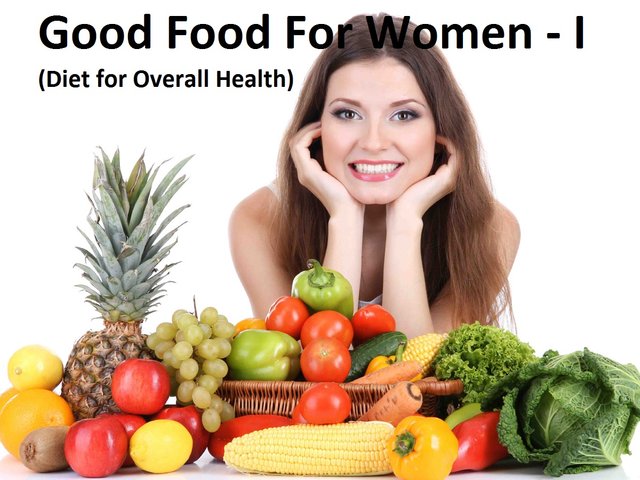Healthy Eating for Women

A balanced diet is the foundation of health. Like men, women should enjoy a variety of healthy foods from all food groups, including whole grains, fruits, vegetables, healthy fats, low-fat or low-fat milk, and high-fat protein. However, women also have special nutritional needs and this change occurs at every stage of a woman's life
Eat right
Nutritious food provides energy for a busy life for women and helps reduce the risk of disease. Healthy eating plan routines include:
- At least three ounces of whole grains such as whole-grain bread, whole-wheat cereal flakes, whole-wheat pasta, brown rice, or oats.
- Three servings of low-fat or high-fat dairy products, including milk, yogurt, or cheese; Or calcium-protected soymilk. (Non-dairy sources of calcium for people who do not consume dairy foods include calcium-fortified foods and beverages, canned fish, and some vegetables))
- Five to five and a half ounces equivalent protein foods such as lean meats, poultry, seafood, eggs, beans, lentils, tofu, nuts, and seeds.
- One and a half to two cups of fruit - fresh, frozen, canned, or dried without added sugar.
- Two and a half cups of colorful vegetables - fresh, frozen, or canned without salt
Iron-rich foods
Iron is important for good health but the amount needed depends on a woman's lifestyle. For example, iron demand is higher during pregnancy and lower after reaching menopause. Foods that provide iron include red meat, chicken, turkey, pork, fish, calories, vegetables, beans, lentils, and some cereals. Plant-based iron sources are more easily absorbed by your body when eaten with vitamin C-rich foods. To get both of these nutrients in the same dish, try cereals preserved with strawberries on top, add tomatoes to a mandarin orange chopped vegetable salad or lentil soup.
Folate (and folic acid) during the breeding years
When women reach the age of delivery folate (or folic acid) plays an important role in reducing the risk of birth defects. Women who are not pregnant need 400 micrograms (mcg) per day. Using adequate amounts of naturally occurring folate such as oranges, green vegetables, beans, and peas will increase your B vitamin intake. There are many foods fortified with folic acids, such as breakfast cereals, some rice, and bread. It is recommended to eat a variety of foods to meet your nutritional needs, but dietary supplements with folic acid may also be necessary. This is especially true for pregnant or breastfeeding women, as their daily folate requirements are 50000 mcg and 500 mcg daily, respectively. Be sure to check with your doctor or registered dietitian before starting any new supplements.
Daily calcium and vitamin D requirements
For healthy bones and teeth, women need to eat a variety of calcium-rich foods every day. Calcium keeps bones strong and helps reduce the risk of osteoporosis, a bone disease where bones become weak and break easily. Some calcium-rich foods include low-fat or low-fat milk, yogurt and cheese, sardines, tofu (made with calcium sulfate), and calcium-fortified foods and beverages such as plant-based milk substitutes, juices, and cereals. Adequate amounts of vitamin D are important and both calcium and vitamin D increase as women age. Good sources of vitamin D include fatty fish, such as salmon, eggs, and dairy foods and beverages such as milk, as well as some plant-based milk substitutes, yogurt, and juice.
Guide alignments for added sugars, saturated fats, and alcohols
Women should be aware of the sources of added sugars, saturated fats, and alcohol.
- Sugars included in the 2020-2025 Dietary Guidelines for Americans recommend limiting sugar to less than 10% of daily calories. Limit sugars associated with sugary sweet drinks, candies, cookies, pastries, and other desserts.
- The 2020-2025 Dietary Guidelines for Americans specify that on days when alcohol is consumed, women of legal age who prefer to drink alcohol (and this is not a contraindication during pregnancy) should limit or reduce the amount of water per drink. A drink equals 12 ounces of beer, 5 ounces of wine, or 1.5 ounces of alcohol. Pregnant women should avoid alcohol altogether.
- Concentrate on sources of unsaturated fats such as vegetable oils, nuts, and seeds instead of saturated fats. Choose low-fat or fat-free dairy products and fat proteins instead of their completely fatty portions.
Balancing calories with activity
Since women generally have less muscle, more body fat, and are smaller than men, they need fewer calories to maintain healthy body weight and activity level. Women who are more physically active may need more calories.
Physical activity is an important part of a woman's health. Regular physical activity helps in muscle strength, balance, flexibility, and stress management.
women fitness
good
must follow
good to know
affactive
well donw
fejomo
balance diet
hlo
lovely